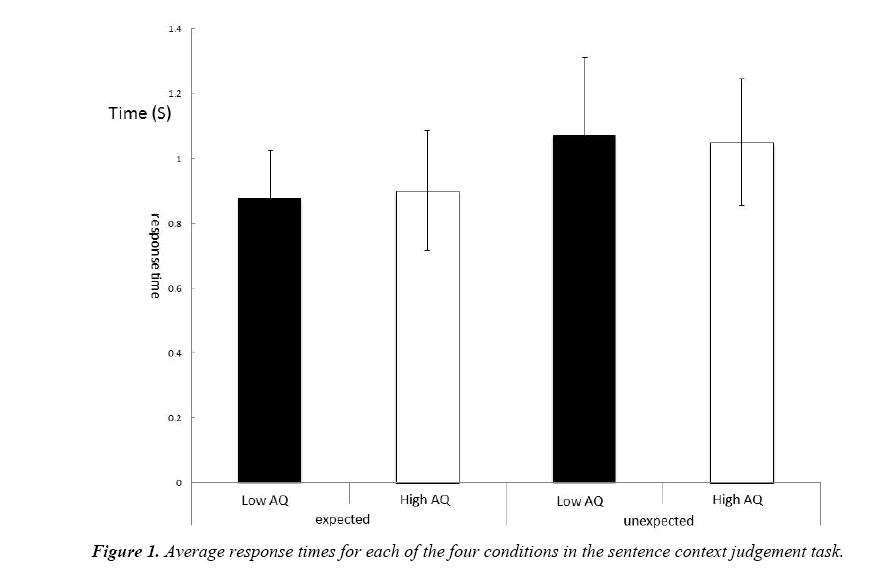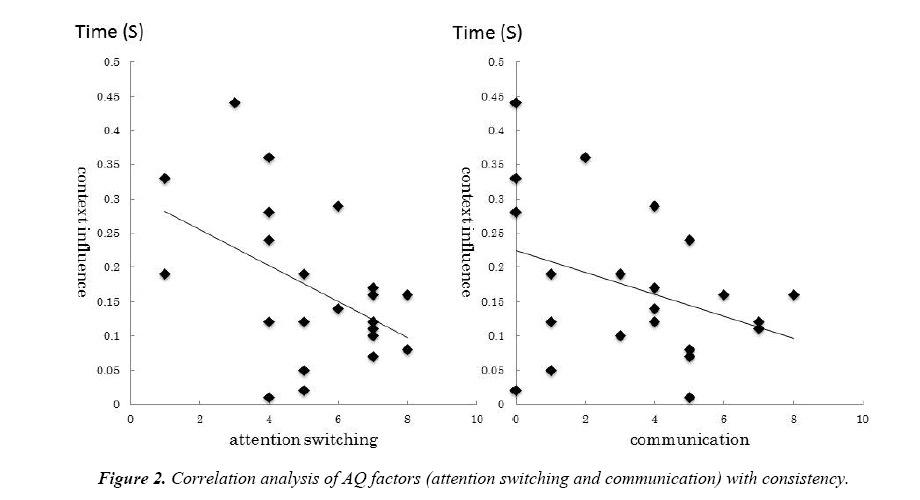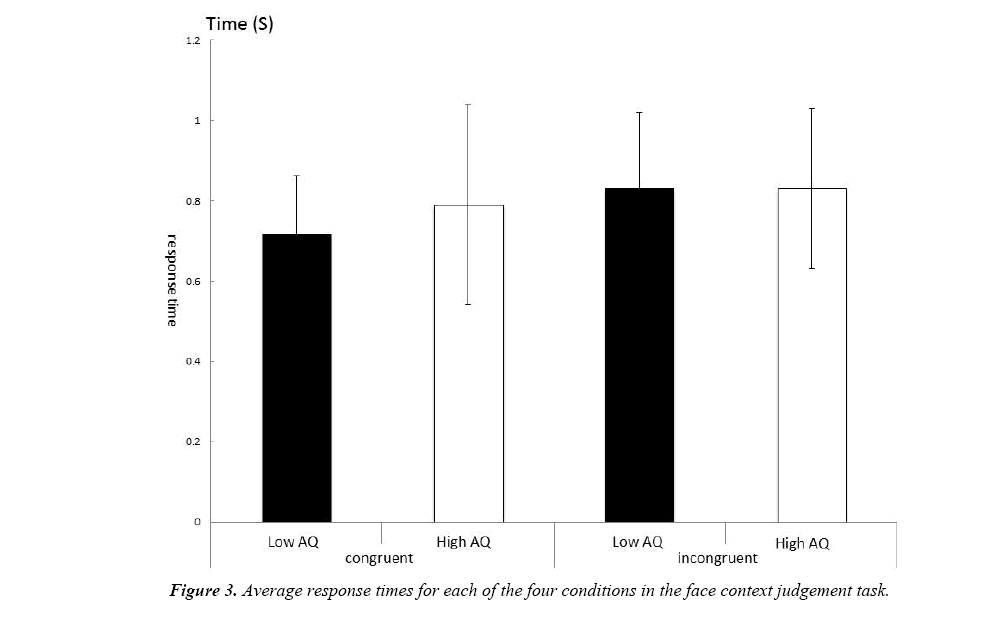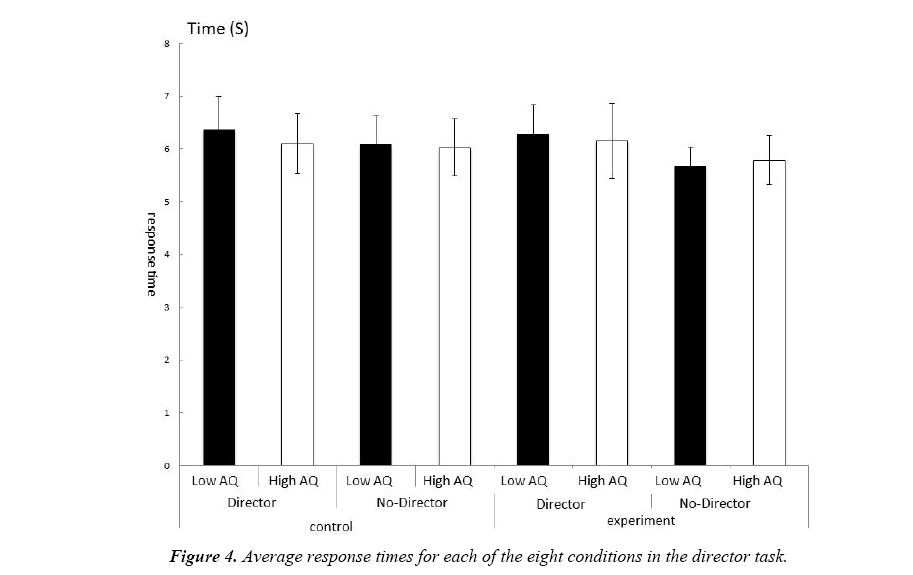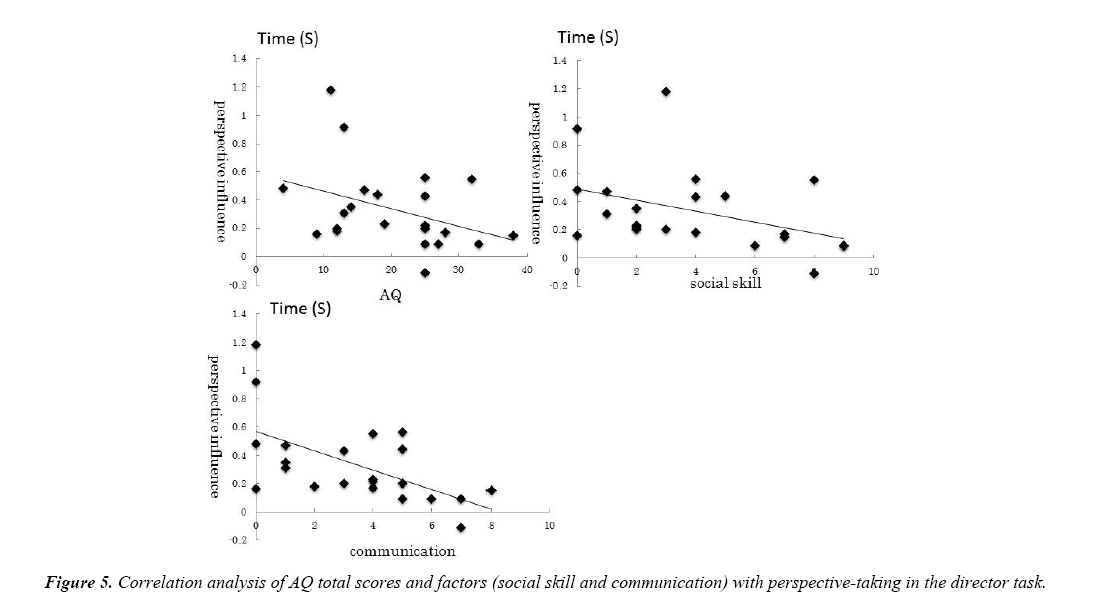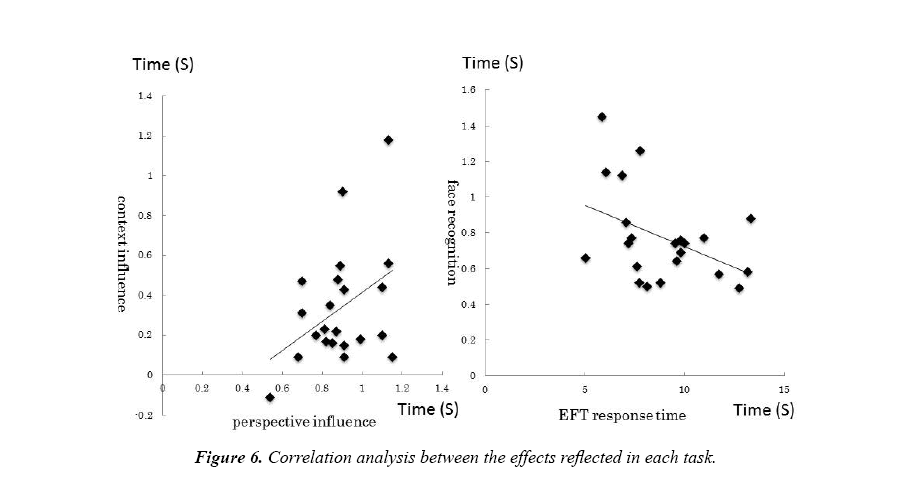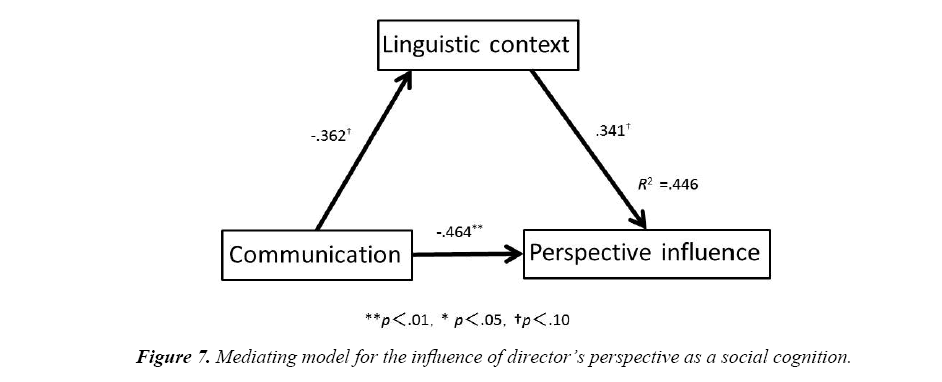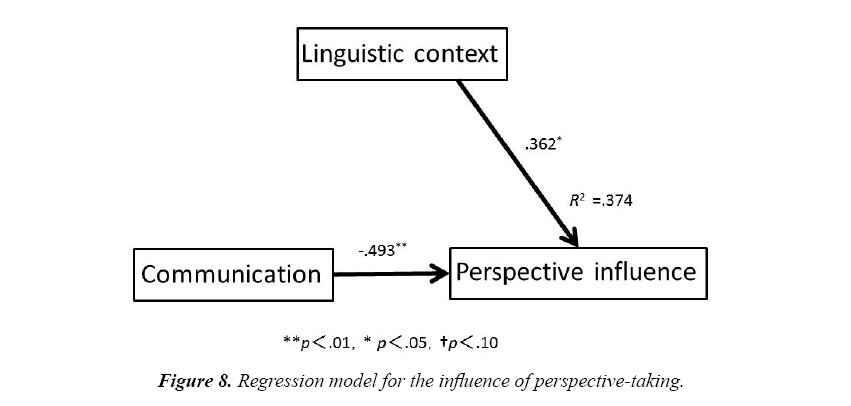Research Article - Neurophysiology Research (2018) Neurophysiology Research (Special Issue 1-2018)
Effects of autistic traits and context use on social cognitions a mediation analysis.
Mitsuhiko Ishikawa1*, Shoji Itakura1, Hiroki Tanabe2
1Department of Psychology, Graduate School of Letters, Kyoto University, Japan
2Department of Psychology, Nagoya University, Japan
- *Corresponding Author:
- Mitsuhiko Ishikawa
Department of Psychology
Graduate School of Letters
Kyoto University
Japan
Tel: 81757532693
E-mail: ishikawa.mitsuhiko.23r@st.kyoto-u.ac.jp
Accepted date: September 24, 2017
Citation: Ishikawa M, Itakura S, Tanabe H. Effects of autistic traits and context use on social cognitions a mediation analysis. Neurophysiol Res. 2017;1(1);3-11
Abstract
The reasons that people with autism spectrum disorders (ASDs) have social difficulties have been a source of debate. One possibility is the idea of context blindness, which stipulates that the lack of spontaneous use of contextual information may be the core deficit of ASD. Here, we examined how autistic traits and the use of context influence social cognitions. Participants were 32 typically functioning adults whose autistic traits were measured to render an Autism Spectrum Quotient (AQ). All participants completed four cognitive tasks: the Embedded Figures Test, a linguistic context judgement task, a social context judgement task, and a Director (perspectivetaking) task. The mediation models were examined via structural equation modelling. The communication factor of the AQ predicted linguistic context use and perspective-taking ability. Linguistic context use explained variance in perspective-taking. However, the indirect effect from the communication factor to perspective-taking through the use of context was not significant. Use of linguistic context may be strongly and independently related to social ability.
Keywords
Autistic-like traits, Context, Social cognition, Mediation analysis, Communication
Introduction
Autism Spectrum Disorder (ASD) is described as a developmental disorder and the main characteristic of ASD is a deficit of sociality. Some cognitive theories have attempted to address atypical autistic cognition. One concept that seeks to explain the social difficulties of people with ASD is called context blindness [1], which refers to a difficulty in using contextual information spontaneously. This difficulty, in turn, leads to social deficits. The idea of context blindness is based in the weak central coherence (WCC) theory, which explains the local processing bias of individuals with ASD in terms of an insufficiency of processing information in context, due either to a deficit in global processing or to a particular strength in local processing [2,3].
The Embedded Figures Test (EFT) has been well validated for processing local information [4]. According to WCC theory, the local processing bias or the deficiency in processing global information enables individuals with ASD to detect the hidden shapes in a complex background more quickly than do typically developing individuals. Additionally, ASD is defined as a continuum from typical development to a diagnosis of autism; therefore, the cognitive styles of non-clinical participants with various levels of “autistic-like traits” have been examined. Autistic-like traits are continuously and normally distributed in the general population [5]. The Autism Spectrum Quotient [6] has been used widely to measure autistic traits, and is a reliable measure of self-reported traits. Typically developing individuals with high AQ scores have been regarded as sharing the cognitive characteristics of people with a diagnosis of autism, including the display of superior performance on the EFT [7,8].
It has been suggested that the autism spectrum shows some independent behavioural characteristics. The AQ comprises five factors that represent the main characteristics of autistic behaviour. The first factor is called social skill, and reflects “social difficulties,” which are regarded as the most specific trait of ASD. The other factor related to WCC theory is “Attention to Detail”. This factor accounts for atypical local processing observed in people with ASD.
Russell-Smith et al. [9] examined how AQ explains superior performance on the EFT. They divided participants into four groups based on their AQ scores: Low Social Difficulties-Low Details; High Social Difficulties-Low Details; Low Social Difficulties-High Details, High Social Difficulties-High Details. Only the Social Difficulties factor showed a significant main effect on mean EFT response times. This result suggests that the social factor is linked strongly to the superior EFT performance.
Burnette et al. [10] conducted some WCC-relevant tasks to examine the relationship between WCC and the ability of theory of mind (ToM). They reported that there was no correlation between the EFT task and the ToM task; however, the homograph task was related to the ToM task. The homograph task requires the use of linguistic context, which suggests that social abilities may be linked to higher-level processing of central coherence, rather than to lower-level processing tasks such as those that require the use of visual context.
The association between WCC theory and social cognition has been examined using experimental tasks, such as the false-belief task [11] and the Reading the Mind in the Eyes Test [12]. However, many studies have produced inconsistent results. As shown by Russell-Smith et al. [9], social difficulties in daily social situations reflected by the AQ were correlated with performance on the EFT. Real social situations requite integration of global information; therefore, WCC should cause social difficulties [3].
Recently, WCC theory has been applied to the idea of context blindness [1]. To expand on the definition of context blindness provided earlier, the concept refers primarily to the difficulties people with ASD have in using context, rather than their usual detailed-focused style of perception, to construct meaning [13]. Vermeulen argued that spontaneous use of context is required in real situations; therefore, people with ASD exhibit social difficulties even if they can perform appropriately in experimental conditions [13].
Recently, to increase ecological validity of the social cognition task, Keyser et al. [14] applied a Director Task (DT) to measure “mind-reading,” one of the social cognitions. Mind-reading is defined broadly to include ToM, perspective-taking and recognition of emotions [15]. Apperly [16] suggested that the DT can assess mind-reading ability. Keyser et al. [14] created the original DT, which used a real shelf and objects; later, Dumontheil et al. [17] developed a computer-based version. With a director standing on the opposite side of the shelf, participants must use perspective-taking to respond correctly regarding what the director sees and knows. Furthermore, functional Magnetic Resonance Imaging has shown that the specific brain regions involved in the director condition include the ToM network, e.g.: superior temporal sulcus and medial prefrontal cortex. In sum, a computer-based DT has sufficient validity for application as a social cognition task [18].
To investigate the relationship between the use of context and social abilities, we adapted the DT as a social cognition task. Also, we proposed to examine effects of autistic traits and context using DT tasks. We used the EFT to measure the influence of visual context, and a sentence context judgement task was adapted to examine the effect of linguistic context. Vermeulen [19] suggested that even without a facial expression, typically developing individuals certainly can infer others’ feelings on the basis of contextual information, while people with ASD may have difficulty using social context. Therefore, we used a task based on judgement of social context from faces in our experiment.
We predicted that participants who scored high on ASD traits would be less affected by contextual information, and based on WCC, all contextual tasks would be correlated. In addition, Vermeulen [1] said that the background of social difficulties in ASD may be a result of limited use of context. Therefore, autistic traits should explain social cognition mediated through context using. Furthermore, we examined the group difference of AQ scores in each task.
Materials and Methods
Participants
Thirty-two Japanese students (17 males, 15 females; mean age 20.81 ± 1.28 years) were recruited from the students in Nagoya University for this study. All participants spoke Japanese as their first language. The average AQ score was 21.31 (SD=7.76). All participants reported normal or corrected-to-normal vision. All participants were naïve to the purpose of this study, and all reported normal or corrected-to-normal vision. In this study, participants were told that the AQ questionnaire just measures personality traits, and AQ test was done only once. The protocol was approved by the ethical committee of the Psychology Department, Faculty of Letters, Nagoya University, Nagoya, Japan. All participants give their written informed consent to participate in the study.
Procedure
All tests were conducted in the cognitive neuroscience experimental room in Nagoya University, Japan. The Japanese version of the AQ [20] was used to measure individual autistic traits. It comprises 50 items that assess five different areas with 10 items each: social skill (e.g.: finding social situations easy), attention switching (e.g.: feeling anxious in new situations), attention to detail (e.g.: noticing patterns in things all the time), communication (e.g.: enjoying social chit-chat), and imagination (e.g.: making up stories easily). Participants were required to choose one of four options (1=“Definitely agree”, 2=“Slightly agree”, 3=“Slightly disagree”, 4=“Definitely disagree”), and each of the items scores 1 point if the respondent saying usual behaviour as abnormal or autistic either mildly or strongly. Instructions were given just before each task. After completing the AQ questionnaire, participants performed the four tasks in random order. After all tasks, participants were told the purpose of this study. The whole session took about 45 minutes.
Embedded figures test (EFT)
In over 35 trials, including five practice trials, participants had to find target shapes included in complex figures. Participants were told that target shapes might appear rotated or in different locations. In this task, target shapes were hidden in one of the four figures, and participants pressed a button to indicate which figure included the target shape. It was predicted that the High AQ group would have faster response times than the Low AQ group.
Sentence context judgement task
Participants read partial sentences that ended with a hyphen, and then the final words of the sentence were presented. When the end of the sentence was presented, participants judged whether the ending was predictable or not. A context-consistent and a context-inconsistent condition were set up, with 20 trials each. As described in previous research, the presentation time of context sentences was configured at 230 ms for each Japanese character. A fixation cross was presented for 100 ms between each trial. Participants pushed the J key if the end of the sentence was predictable based on the context and the F key if the ending was unpredictable. If participants were predicting the endings from context, the context-consistent condition should show faster response times than the context-inconsistent condition. It was also predicted that the Low AQ group would be more vulnerable to this effect of context consistency, while the High AQ group might not be influenced by contextual flow at all. In correlation analysis, higher AQ would be related to a smaller difference when response times for the context-consistent condition were subtracted from the context-inconsistent condition.
Face context judgement task
This task required participants to infer the emotions conveyed by sentences and to judge whether subsequently presented facial expressions were consistent or inconsistent with those emotions.
Participants pressed the J key to indicate “consistent” and the F key to indicate “inconsistent”. Sentences were selected on the basis of a preliminary investigation. The face-consistent and face-inconsistent conditions comprised 24 trials each. After this task, to check the difficulty of understanding facial expressions, only facial stimuli were presented and participants judged whether the faces were smiling or sad. This task comprised of 16 trials. It was predicted that the Low AQ group would have faster response times in the face-consistent condition than in the face-inconsistent condition, and that the High AQ group would be influenced less or not at all by contextual face consistency.
Director task
Participants listened through the speakers to a “Director”, who was standing on the opposite side of the shelf and talking about a particular object; using a mouse, the participants clicked on the single object to which they thought the Director was referring. Stimuli were portrayed as eight different objects on a 4 × 4 vertical grid of shelves (see supplemental information). There were five slots occluded from the view of the Director. This task used two within-subjects factors (Condition: Director, or No- Director; and Trial type: Control or Experimental). Here, the No-Director condition means there is was no Director visibly present on the opposite side of the shelves. Each condition comprised 10 trials. Participants were instructed to listen carefully to the Director’s instructions. In each trial, the Director instructed the participant to select one of the eight objects. The Director’s instructions included the object’s relative place (upper or lower) or size (biggest or smallest), e.g.: “the smallest ball” (originally Japanese words). Participants were required to take account of the director’s perspective when there was a visible Director, while in No-Director condition they responded from their own perspective. In the Director condition, the correct response was to click the target object, which could be seen by the Director. There was a distractor in the Experimental conditions, which was the same categorical object as the target object, but not the one to which the Director was referring. Auditory instructions lasted approximately 5 seconds. The order of stimulus presentation was random. The High AQ group was predicted to take longer than the Low AQ group in the Director Experimental condition. In addition, participants with high AQ scores were expected to have difficulty taking the Director’s perspective, so the difference in response time when the No- Director condition was subtracted from the Director condition was anticipated to be correlated positively with AQ.
Apparatus and stimuli
For presenting visual stimuli, RDT231WM-X monitor (Mitsubishi, Japan) was used. Auditory stimuli were presented through Rev A00 speakers (DEL, USA). The program was written using PsychoPy version 1.83 [21]. In the EFT, target shapes were presented on the left side of the screen, and four complex shapes were displayed to the right of the target shapes. Those items were created using www.IndiaBIX.com, which is an open database. In the Sentence Context judgement task, context was created using one or two short sentences. All sentences were chosen by a preliminary investigation that measured predictability of the end of the sentence.
Another preliminary investigation was conducted to select emotional situations for the Face Context judgement task, which asked how happy or sad the face was. Facial stimuli were selected from the ATR facial stimuli database (ATR Promotions, Inc., Kyoto, Japan), and four photographic subjects (2 males, 2 females) expressing both smiles and sad faces were chosen. The presentation order of facial stimuli was randomised for each participant.
Daily objects such as a ball and a hat were used for the DT. Auditory instructions were pre-recorded by ICR-S280RM (SANYO Electric, Japan). Auditory instructions referred to the respective object’s position (upper or lower) or the size (biggest or smallest) before the categorical name of the object.
Results
Prior to analysis, the experimental data were screened for univariate outliers (scores or response time more than two standard deviations from the mean). To examine group differences, we divided participants into a High AQ and a Low AQ group according to frequency distribution of scores,using the data from participants who had the top 11 and bottom 11 scores . As a result, the High AQ and Low AQ groups each comprised 11 participants (mean AQHigh=28.00, SD=4.43; mean AQLow=12.82, SD=4.17).
EFT
The mean percentage of correct answers was 86.4% (SD=5.99). Only correct responses were used for the response time analysis. The mean response time was 8.92s (SD=2.38). To examine group differences in mean percentage of correct answers and response times, a t-test with the two levels of AQ (High, Low) was conducted. No significant difference was seen for either measure (percentage of correct answers: t(20)=0.254, p=0.802; response times: t(20)=0.232, p=0.819). Similarly, the correlation analyses for percentage of correct answers or response times and AQ total scores or AQ factor scores also did not indicate any significant relationships.
Sentence context judgement task
All participants answered more than 90% of the context consistency trials correctly. For mean response times, a 2 × 2 analysis of variance (ANOVA) with two levels of AQ (High, Low) and two levels of context condition (Consistent, Inconsistent) was conducted. The main effect of context condition was significant (F (1, 20)=51.100, p<0.001, ηp2=0.719), and the Context-consistent condition was faster than the Context-inconsistent condition. The result of subtracting the Context-consistent response times from the Contextinconsistent response times was analysed for its correlation with AQ total score and AQ factor scores. The attention to detail factor showed a significant negative correlation (r=-0.471, p=0.027), and the communication factor revealed a negative trend (r=-0.362, p=0.098) (Figures 1 and 2).
Face context judgement task
All participants achieved greater than 90% accuracy in the face consistency task. For mean response times, a 2 × 2 ANOVA with two levels of AQ (High, Low) and two levels of face condition (Consistent, Inconsistent) was conducted. The main effect of face condition was significant (F (1, 20)=10.153, p=0.005, ηp2=0.337), and the Consistent condition was faster than the Inconsistent condition. Additionally, the facial expressionchecking task was examined by ANOVA, with two levels of AQ (High, Low) and two levels of facial expression (Smile, Sad); however, no significant differences were observed. Correlation analysis of the difference between the Consistent condition and the Inconsistent condition with AQ total score and AQ factor scores revealed no significant relationship (Figure 3).
Director task
For mean response times, a 2 × 2 × 2 ANOVA with two levels of AQ (High, Low), two levels of Director condition (Director, No-Director) and two levels of trial type (Control, Experiment) was conducted. The interaction of Director condition and trial type was significant (F (1, 20)=14.177, p=0.001, ηp2=0.415), as was the interaction of AQ and Director condition (F (1, 20)=3.672, p=0.070, ηp2=0.155). Post-hoc t-tests corrected by the Bonferroni method indicated that the Director condition had longer response times than the No-Director condition in both Control and Experiment trials (p=0.008, ηp2=0.304; p<0.001, η2=0.651). Also, in the No-Director condition, the response times in the Experimental condition were faster than those in the Control condition (p<0.001, η2=0.629). Both High and Low AQ groups had longer response times in the Director condition than in the No-Director condition (p=0.014, η2=0.265; p<0.001, η2=0.593). In addition, the main effects of Director condition and trial type were significant (F (1, 20)=32.639, p<0.001, ηp2=0.620, F (1, 20)=11.001, p=0.003, ηp2=0.355). The Director condition took longer than the No-Director condition, and the Experiment condition took less time than the Control condition. In the ANOVA for the percentage of correct answers, only the trial type main effect was significant, and the Experimental condition showed more incorrect responses than did the Control condition (F (1,20)=18.473, p<0.001, η2=0.480). There was no effect of AQ on the percentage of correct answers. The difference in response times between the No-Director and Director conditions can be considered the effect of taking the Director’s perspective, therefore correlation analysis was conducted with this subtracted response time and the AQ total score as well as each AQ factor score. Results indicated that total AQ score and the social skill factor score were correlated negatively with the subtracted response times, respectively (r=-0.378, p=0.083, r=-0.401, p=0.064). In addition, the communication factor showed a strong negative correlation with the subtracted response times (r=-0.587, p=0.004) (Figures 4 and 5).
Correlation analysis between each task
Simple correlation analyses were conducted between five variables: the response time on the EFT; the subtracted response time of the Context-consistent condition from the Context-inconsistent condition in the sentence context judgement task (linguistic context); the subtracted response time of the Face-consistent condition from the Face-inconsistent condition (facial context); the response time in the facial expression-checking task; and the subtracted response time of No-Director condition from Director condition (perspective-taking). Of these, linguistic context and perspective-taking were significantly and positively correlated (r=0.509, p=0.016). Also, the EFT response time was significantly and negatively correlated with the response time in the facial expression-checking task (r=-0.425, p=0.049) (Figure 6).
Structural equation modelling (SEM)
The mediating model was examined via structural equation modelling (SEM) using the AMOS program [22]. We hypothesised that autistic traits can explain the social cognition of perspective-taking, mediated by context use. The communication factor was chosen from the AQ, because it had correlated with use of linguistic context and with perspectivetaking.
The communication factor predicted the influence of linguistic context, and the influence of linguistic context also explained significant variance in perspective-taking (β=-0.362, p=0.075, β=0.341, p=0.051). Perspective-taking was significantly predicted by the communication factor (β=-0.464, p=0.008).
In addition, indirect effects were examined using bootstrap estimation. As suggested by Shrout and Bolger [23], 1000 bootstrap estimations were conducted and confidence intervals were obtained. The bias-corrected confidence interval was calculated. Confidence intervals that did not include zero were considered significant. The indirect effect mediating linguistic context was not significant (β=0.137, CI [-0.358, 0.038]). The multiple regression model explaining the influence of perspective-taking was also examined. Both the communication factor and the influence of linguistic context predicted the influence of perspective-taking significantly (β=-0.493, p=0.004, β=0.362, p=0.036) (Figures 7 and 8).
Discussion
Our hypothesis was that the influence of context is different as a function of the level of autistic traits, and that AQ explains the social cognition that mediates context use. The influence of context in a sentence contextual judgement task and the influence of taking another’s perspective in the Director task were correlated with the communication factor of the AQ. In the mediating model, the communication factor can explain the influence of taking another’s perspective through the use of linguistic context; however, the indirect effect was not significant.
In this study, the EFT and the AQ did not show any relationship. Many studies have suggested an association between the EFT and autistic traits; however, there are also some reports of null results. For instance, Halliday et al. [24] found no relationship between AQ and the EFT. Burnette et al. [10] examined differences in EFT performance between children with ASD and typically developing children, and no difference was confirmed. These results suggest that visual central coherence may not be decreased in people with ASD. It is necessary to examine what kind of global information integration is weakened in ASD. Also, the response times in the EFT and facial expression-checking tasks were negatively correlated. Wyer et al. [25] examined the relationship between the EFT and facial expression recognition, and suggested that visual central coherence can influence understanding of facial expressions. Furthermore, Calder and Jansen [26] showed that overall processing can play an important role in distinguishing facial expressions; therefore, one can speculate that the ability of global information processing and facial recognition should be related. Our results also indicated that central coherence reflected in the EFT predicts facial expression understanding, but AQ did not correlate with either of these. To summarise, in the present study, central coherence can be reflected in the EFT and the facial expression-checking task, but autistic traits may be unrelated to visual central coherence.
The sentence context judgement task and the face context judgement task revealed a main effect of context. In the Consistent condition, response times decreased, perhaps because participants predicted the target automatically from contextual information. The AQ showed no interaction with either task. Also, the influence of linguistic context and the communication factor were correlated. Successful performance of the facial context judgement task did not require the use of linguistic context; however, participants had to consider linguistic contextual streams when they responded in the sentence context judgement task. Therefore, higher-level linguistic contextual processing was required in the sentence context judgement task. Because the communication factor reflects difficulties with communicating in social situations, sociality may be affected by the use of linguistic context.
Although the face context judgement task required the same key response as the sentence context judgement task, judging context consistency, there was no relationship with AQ. To simplify the effect of emotion, we only used two kinds of facial expressions, smiling and sad. For this reason, participants could respond with a simple positive or negative judgement without using context carefully.
The DT showed two interactions (AQ with Director Condition; Trial type with Director Condition), and according to the result of post-hoc t-tests, the Director condition appeared to affect response times strongly. It has been argued that egocentric bias can be observed in the DT [17]. Because egocentric bias leads individuals to think about things from their own point of view too much, the participant’s own perspective may disturb taking the Director’s perspective, and this may have caused response times to increase. The Control condition produced lower accuracy than did the Experiment condition. This may be because participants failed to take the Director’s perspective in the Experiment condition with a Director. In addition, in the Experiment condition without a Director, there were more objects in the same category as the target object, so these objects could have served as distractors. In addition, negative correlations were observed between AQ scores and the influence of taking the Director’s perspective, especially with the factors related to sociality, social skill and communication. One might therefore suggest that people who experience difficulties in social situations may be relatively unaffected by others’ perspectives. In Santiesteban et al. [27], ASD was not associated with different response time relative to typically developing individuals. The author argued that this is because the DT only requires explicit mentalizing, meaning to use ToM with the instruction to think from the viewpoint of another’s mind, which individuals with ASD can also do. As mentioned in Frith and Frith [28], the concept of mentalizing includes not only use of a ToM but also mental distribution, such as perceiving agency of objects that do not have mental states in the real sense. The computerbased DT uses a picture of a human as Director, and the regions known as social brains also activated in response to the task; therefore this computer-based task can be considered a social cognition task with high validity [18]. However, in our study, some participants with high levels of autistic traits reported that they just concentrated on which shelves were occluded without thinking of the Director’s mental states. Therefore, people with high autistic traits may not be inclined to think through other’s mental states, but they can achieve the goal of perspective-taking tasks using other strategies. Wheelwright et al. [29] reported that people with high AQ scores have a cognitive style called systemising. Systemising is defined as the drive to analyse, understand, predict, control and construct rule-based systems. Our results for the DT can be explained by this cognitive style. In other words, although the DT is intended to be performed with consideration of the Director’s mental state as to which objects can be seen, people with high autistic traits may have created a rule of response, e.g.: if the Director is standing on the opposite side of the shelves, medium-sized objects will be targets, no matter whether the biggest or smallest objects were instructed. The systemizing cognitive style can create strategies to achieve task goals in experimental conditions, so further studies on the relationship between social cognitions and systemizing in social situations is necessary to understand the social difficulties of people with ASD or high autistic traits in the daily lives.
The result of mediation analysis indicated that the communication factor predicts the influence of linguistic context and the influence of linguistic context also explains the influence of taking the Director’s perspective. Also, the influence of perspective-taking was significantly predicted by the communication factor. The communication factor reflects difficulties with communication in social situations, such as understanding a joke that has been told. To understand irony or jokes depends strongly on context [1], therefore, use of linguistic context should be related to this factor. Additionally, sharing of mental states with others in social relationships is mainly done linguistically. For these reasons, the communication factor and the use of linguistic context may be related to social cognition. Although the two factors were correlated, the indirect effect was not significant. In addition, the multiple regression model explained the influence of perspective-taking better than the mediating model did. These results suggest that the combination of the communication factor and the use of linguistic context may not be the core factor for explaining deficits in social cognition.
Some limitations were considered in this study. First, the small number of participants may affect the results. Many studies have reported the relation between AQ and the ability of social cognition, therefore its correlation may have strong effect size. It can be a limitation to interpret the results of mediation analysis. Also, we conducted only the DT to measure the ability of social cognition. Other social cognition tasks using linguistic information, such as false-belief task, may have been related to the use of context.
Conclusion
In this study, the use of context did not mediate between autistic traits and social cognition. However, it was found that the communication factor of the AQ and the use of linguistic context are both strongly and independently related to perspectivetaking. The function of language has been thought to compensate for the use of ToM in people with ASD, according to Beppu and Nomura [30]. They suggested that children with ASD cannot perceive another’s mind intuitively; however, they attempt to reason about mental states using linguistic clues. The limited use of context may be a mild cognitive deficit in people with ASD. Therefore, promoting the use of contextual information could affect social cognitions positively. Further studies on the use of context and social cognition are necessary.
References
- Vermeulen, P. Autismas Context Blindness. Kansas City, MO: Autism Asperger Publishing. 2012.
- Happé F, Frith U. The neuropsychology of autism. Brain. 1996;119(4):1377-1400.
- Happé F, Frith U. The weak coherence account: detail-focused cognitive style in autism spectrum disorders. J Autism DevDisord. 2006;36(1):5-25.
- Bölte S, Holtmann M, Poustka F, et al. Gestalt perception and local-global processing in high-functioning autism. J Autism Dev Disord. 2007;37(8):1493-1504.
- Skuse DH, Mandy W, Steer C, et al. Social communication competence and functional adaptation in a general population of children: preliminary evidence for sex-by-verbal IQ differential risk. J Am Acad Child Adolesc Psychiatry. 2009;48(2):128-137.
- Baron Cohen S, Wheelwright S, Skinner R, et al. The autism-spectrum quotient (AQ): Evidence from asperger syndrome/high-functioning autism, malesand females, scientists and mathematicians. J Autism Dev Disord. 2001;31(1):5-17.
- Almeida RA, Dickinson JE, Maybery MT, et al. A new step towards understanding Embedded Figures Test performance in the autism spectrum: The radial frequency search task. Neuropsychologia. 2010;48(2):374-381.
- Russell SS, Maybery M, Bayliss D. Are the autism and positive schizotypy spectra diametrically opposed in local versus global processing? J Autism Dev Disord. 2010;40(8):968–977.
- Russell SN, Maybery MT, Bayliss DM, et al. Support for a link between the local processing bias and social deficits in autism: an investigation of embedded figures test performance in non-clinical individuals. J Autism Dev Disord. 2012;42(11):2420-2430.
- Burnette CP, Mundy PC, Meyer JA, et al. Weak central coherence and its relations to theory of mind and anxiety in autism. J Autism Dev Disord. 2005;35(1):63-73.
- Happé FG. Central coherence and theory of mind in autism: Reading homographs in context. British J Dev Psychol. 1997;15(1):1-12.
- Beaumont R, Newcombe P. Theory of mind and central coherence in adults with high-functioning autism or Asperger syndrome. Autism. 2006;10(4):365-382.
- Vermeulen P. Context blindness in autism spectrum disorder not using the forest to see the trees as trees. Focus Autism Other Dev Disabl. 2014;30(3):182-192.
- Keysar B, Barr JD, Balin AJ, et al. Taking perspective in conversation: the role of mutual knowledge in comprehension. Psychol Sci. 2000;11(1):32-38.
- Furumi F, Koyasu M. Does experience with role play activate “mindreading” in a perspective-taking task? Jpn J Psychol. 2012;83(1):18-26.
- Apperly IA. Mindreaders: The cognitive basis of “theory of mind”. London, UK: Psychology Press. 2011.
- Dumontheil I, Apperly IA, Blakemore JS. Online usage of theory of mind continues to develop in late adolescence. Dev Sci. 2010;13(2):331-338.
- Dumontheil I, Küster O, Apperly IA, et al. Taking perspective into account in a communicative task. Neuroimage. 2010;52(4):1574-1583.
- Vermeulen P. Autism: from mind blindness to context blindness. Asperger’s Digest. 2011.
- Wakabayashi A, Tojo Y, Baron CS, et al. The Autism-Spectrum Quotient (AQ) Japanese version: Evidence from high-functioning clinical group and normal adults. Jpn J Psychol. 2004;75(1):78-84.
- Peirce JW. PsychoPy-psychophysics software in Python. J Neurosci Methods. 2007;162(1):8-13.
- Arbuckle JL. Computer announcement amos: analysis of moment structures. Psychometrika. 1994;59(1):135-137.
- Shrout PE, Bolger N. Mediation in experimental and nonexperimental studies: new procedures and recommendations. Psychol Methods. 2002;7(4):422-445.
- Halliday DW, MacDonald SW, Sherf SK et al. A reciprocal model of face recognition and autistic traits: evidence from an individual differences perspective. PloS One. 2014;9(5):e94013.
- Wyer NA, Martin D, Pickup T, et al. Individual differences in (non-visual) processing style predict the face inversion effect. Cogn Sci. 2012;36(2):373-384.
- Calder AJ, Jansen J. Configural coding of facial expressions: The impact of inversion and photographic negative. Visual Cognition. 2005;12(3):495-518.
- Santiesteban I, Shah P, White S, et al. Mentalizing or submentalizing in a communication task? Evidence from autism and a camera control. Psychon Bull Rev. 2014;22(3):844-849.
- Frith U, Frith CD. Development and neurophysiology of mentalizing. Philos Trans R Soc Lond B Biol Sci. 2003;358(1431):459-473.
- Wheelwright S, Baron CS, Goldenfeld N, et al. Predicting autism spectrum quotient (AQ) from the systemizing quotient-revised (SQ-R) and empathy quotient (EQ). Brain Res. 2006;1079(1):47-56.
- Beppu S, Nomura K. Do children with high functional autism have a different theory of mind than normal children? Japn J Dev Psychol. 2005;16(3):257-264.
